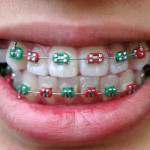
The application of fixed appliance orthodontic appliances encourages the accumulation of oral biofilm. During treatment good quality oral hygiene is important to prevent the development of gingivitis, enamel demineralization and white spot lesions. Reviews have demonstrated that powered toothbrushes reduce plaque and gingivitis by more than manual brushes. The small head size of the powered toothbrush is also considered to assist effective oral hygiene when wearing appliances.
The aim of this review was to compare manual and powered toothbrushing during fixed orthodontic appliance treatment with regards to the removal of plaque, the health of the gingivae, and patient experience.
Methods
Searches were conducted in the Cochrane Oral Health Group’s Trials Register and CENTRAL Medline/PubMed, Scopus, Web of Science, Google Scholar, www.ClinicalTrials.gov, the National Research Register, and Pro-Quest Dissertation Abstracts and Thesis databases with no language restrictions. Randomised controlled trials (RCTs) of powered versus manual toothbrush use in patients undergoing fixed appliance orthodontic treatment were included. Primary outcome measures were plaque or gingival indices. Cross-over and split-mouth studies were excluded. Two reviewers independently extracted data and assessed study quality using the Cochrane Risk of Bias tool. Mean difference (MD) and 95% confidence intervals (CI) were calculated and random effects meta-analysis conducted.
Results
- 7 RCTs were included involving a total of 437 patients.
- Follow times range from 4-20 weeks.
- 1 study was at low risk of bias, 4 at unclear risk and 2 at high risk
- 5 studies contributed to the meta-analyses with no statistically significant differences seen between powered and manual brushes for plaque or gingival indices at 4 or 8 weeks.
| Indices | No of studies | Mean difference (95%CI) |
| Plaque – 4 weeks | 2 | 0.05 (-0.04 to 0.13) |
| Plaque – 8 weeks | 2 | 0.11 (-0.10 to 0.33) |
| Gingival – 4 weeks | 5 | -0.02 (-0.06 to 0.02) |
| Gingival – 8 weeks | 5 | -0.01 (-0.05 to 0.02) |
- No studies assessed patient experiences or compliance.
Conclusions
The authors concluded: –
There is no difference between manual or powered toothbrushing in fixed orthodontic patients in plaque indexes or gingival index at 4-week and 8-week follow up.
There is a need for well-designed RCTs to compare short and long term effects between manual and powered toothbrushes to increase our confidence in these findings, which is very low to moderate.
Standardised indexes to evaluate plaque and gingivitis for orthodontic patients should be agreed on.
Patient experience and compliance with both toothbrushes should be included as an outcome measure in future RCTs.
Future studies should also include the potential factors that may affect the clinical choices, such as age, health status, education level, and financial factors.
Comments
The authors searched a broad range of databases but have only included English language studies. While the authors have assessed 5 of the included studies as being at low risk of bias only one study was at low risk of bias for all 6 domains of the Cochrane domains-based tool. Interestingly an earlier systematic review of this topic (Dental Elf – 15th Dec 2017) included nine RCTs compared with the 7 of this review with only 5 studies being common to both reviews. What is clear from both reviews is that there is a limited amount of low-quality evidence to assess whether powered brushes are more effective than manual brushes for maintaining oral health while undergoing fixed appliance orthodontic treatment. As the authors of this new review point out the available studies are of relatively short duration given that fixed orthodontic treatment typically take up to 2 years to complete. Consequently, well conducted and reported trials of appropriate size and duration are needed to provide better evidence on the most effective toothbrush to use during orthodontic treatment.
Links
Primary Paper
ElShehaby M, Mofti B, Montasser MA, Bearn D. Powered vs manual tooth brushing in patients with fixed orthodontic appliances: A systematic review and meta-analysis. Am J Orthod Dentofacial Orthop. 2020 Sep 17:S0889-5406(20)30425-X. doi: 10.1016/j.ajodo.2020.04.018. Epub ahead of print. PMID: 32951930.
Other references
Dental Elf – 15th Dec 2017
Dental Elf – 18th Jun 2014
Powered toothbrushes reduced plaque and gingivitis more than manual toothbrushes
